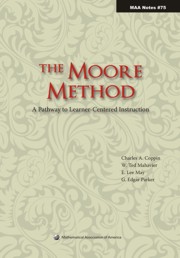Book contents
- Frontmatter
- Contents
- Dedication
- Acknowledgements
- 1 Introduction
- 2 Moore's Moore Method
- 3 What is the Moore Method?
- 4 On Culture
- 5 Development and Selection of Materials
- 6 In the Classroom
- 7 Grading
- 8 Why Use the Moore Method?
- 9 Evaluation and Assessment: Effectiveness of the Method
- 10 Frequently Asked Questions
- Appendices
- About the Authors
- References
- Index
2 - Moore's Moore Method
- Frontmatter
- Contents
- Dedication
- Acknowledgements
- 1 Introduction
- 2 Moore's Moore Method
- 3 What is the Moore Method?
- 4 On Culture
- 5 Development and Selection of Materials
- 6 In the Classroom
- 7 Grading
- 8 Why Use the Moore Method?
- 9 Evaluation and Assessment: Effectiveness of the Method
- 10 Frequently Asked Questions
- Appendices
- About the Authors
- References
- Index
Summary
“The greatest sign of success for a teacher…is to be able to say, ‘The children are now working as if I did not exist.’”
—Maria Montessori“Education is what remains after one has forgotten everything one learned in school.”
—Albert Einstein(Coppin) Herein is an attempt to give the reader a snapshot of what an R. L. Moore class was like by examining a particular course of his I took in 1964 and 1965. Contemporaneous classmates will have an account that may vary somewhat from my own but I believe those differences are not of a different species.
Some background may be in order so that the reader may have a backdrop against which to judge a class like this. I went to graduate school during the social revolution of the 1960s that included civil rights marches, demonstrations in the streets and the assassinations of John F. Kennedy, Martin Luther King and Robert F. Kennedy. My contemporaries were products of the decades containing World War II, the Korean Conflict, the Vietnam War and, of course, the Cold War. This was a time colored by a potential worldwide nuclear conflagration. We were Sputnik's children. We thought our country was behind in the space race. Many of my generation decided to go into mathematics and science because we wanted to contribute to our nation's defense and its existence. This was the milieu in which my classmates and I found ourselves doing mathematics.
- Type
- Chapter
- Information
- The Moore MethodA Pathway to Learner-Centered Instruction, pp. 7 - 12Publisher: Mathematical Association of AmericaPrint publication year: 2009



